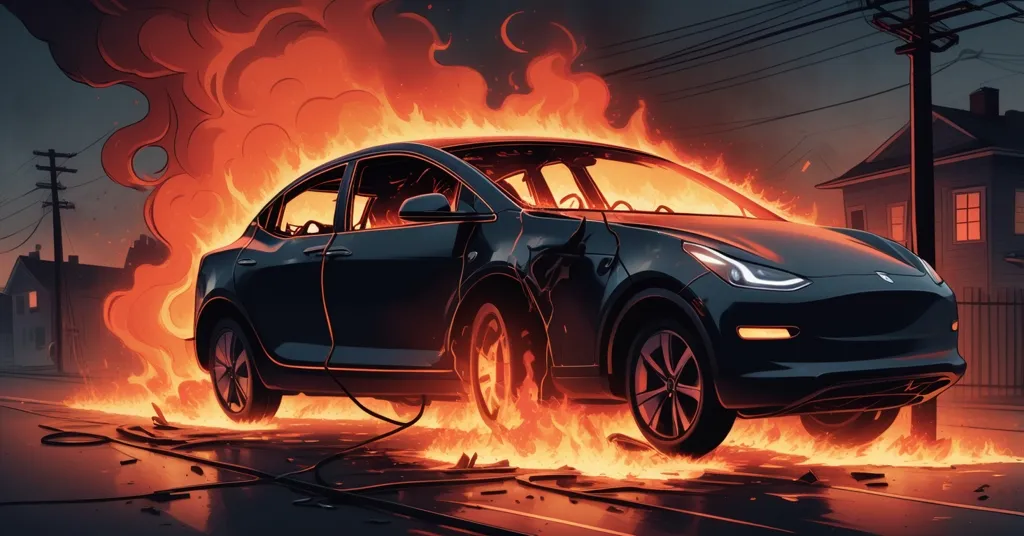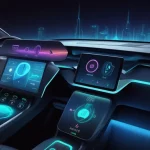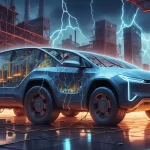Tesla Lawsuit: Fatal Crash Sparks Outrage Over Deadly Door Design Flaw

Tesla Lawsuit: Deadly Door Design Flaw Tied to Fatal Washington Crash
Tesla, the electric vehicle titan, faces a brutal reckoning with a new lawsuit filed in the U.S. District Court of Washington. The case stems from a tragic January 2023 crash involving a Tesla Model 3 that killed Wendy Dennis and left her husband Jeffery severely injured. The plaintiffs slam Tesla for negligence, pointing to defective door handles that allegedly trap occupants post-crash, alongside sudden acceleration issues and fire hazards from lithium-ion batteries. This isn’t just a single tragedy—it’s the latest in a string of incidents raising serious questions about Tesla’s safety priorities.
- Fatal Incident: Tesla Model 3 crashes in Washington, January 2023, resulting in one death and severe injuries.
- Legal Action: Lawsuit accuses Tesla of negligence over door design and known safety risks.
- Wider Concerns: Multiple similar cases and growing scrutiny over electric vehicle safety flaws.
The Washington Tragedy: A Family’s Nightmare
On a cold January day in 2023, a Tesla Model 3 in Washington state veered into a utility pole with devastating force. The lawsuit claims the car accelerated uncontrollably—meaning it allegedly sped up without driver input, a recurring accusation in Tesla-related cases. The impact triggered a fire, fueled by the vehicle’s lithium-ion battery, which can ignite at temperatures exceeding 2,000°F, far beyond what standard firefighting gear can handle. Wendy Dennis died at the scene, trapped inside the inferno. Her husband, Jeffery, survived but sustained horrific burns that will scar him for life.
Bystanders rushed to the wreckage, desperate to save the couple. But they encountered a nightmarish barrier: Tesla’s electric door handles wouldn’t budge. With no power to operate them after the crash, the doors became a steel cage. Some even grabbed a baseball bat, smashing at the windows in a frantic bid to reach the Dennises, but it was too late for Wendy.
“Several bystanders ran to the vehicle and attempted to assist Jeff and Wendy Dennis, but the Model 3’s door handles would not operate. Several good Samaritans even attempted to use a baseball bat to break the car windows to help the Dennisses out of the burning vehicle.” – Couple’s lawyers
The lawsuit, filed last Friday, doesn’t hold back. It accuses Tesla of misleading customers about the safety of its vehicles, alleging the company knew about the door handle flaws and the risk of battery fires but failed to act. Beyond the design issues, the plaintiffs claim Tesla’s marketing hyped the Model 3 as a pinnacle of safety and innovation, a promise shattered in the burning wreckage. While specific damages sought remain undisclosed, the legal filing seeks to set a precedent, holding Tesla accountable for what the lawyers call a preventable tragedy. For more details on this case, check out the full report on the Tesla lawsuit over fatal crash in Washington.
Tesla’s Design Dilemma: Style Over Safety?
At the heart of this lawsuit lies Tesla’s signature door handle design—sleek, concealed, and undeniably futuristic. These handles rely on a small backup power source, often called a low-voltage battery, to pop out and allow entry or exit. But here’s the fatal catch: if that power source fails during a crash, the handles become useless, locking passengers inside. Manual overrides do exist, hidden in obscure spots like under trim panels, but they’re often unknown to owners or impossible to access in a panic as smoke and flames close in.
Then there’s the issue of lithium-ion battery fires, a known hazard in all electric vehicles, not just Tesla’s. Unlike a gasoline car fire, which burns at lower temperatures and can often be doused with standard hoses, EV battery fires are a beast of their own. They can reach extreme heat almost instantly, releasing toxic fumes and requiring specialized foam or massive amounts of water to extinguish—tools many first responders don’t have on hand. Tesla’s battery packs, while innovative for performance and range, aren’t uniquely shielded from this risk compared to competitors, leaving occupants vulnerable if they can’t escape.
Critics argue Tesla has long prioritized aesthetics over practicality. Those flush, hidden handles scream cutting-edge design, but at what cost? When innovation means a family burns alive because rescuers can’t open a door, the line between progress and negligence blurs. Sure, Tesla has pushed the world toward sustainable transport, and I’m all for disrupting the fossil fuel dinosaurs. But safety can’t be an afterthought—especially when lives are the price of a sexy silhouette.
A Pattern of Fatal Flaws
The Washington crash isn’t a one-off horror story. Across the U.S., Tesla’s door design has been implicated in multiple lawsuits, painting a grim picture of systemic failure. In Wisconsin, a Model S crash claimed five lives, with rescuers powerless to open the doors as the car became a tomb. In Piedmont, California, a Cybertruck accident killed three college students under eerily similar circumstances. But perhaps most heart-wrenching is the Murrieta, California case—three teenagers, full of dreams and laughter, burned alive as bystanders pounded helplessly on unyielding doors, unable to save them from the flames.
These aren’t isolated flukes. The National Highway Traffic Safety Administration (NHTSA) has documented cases where occupants, including children, were trapped inside burning Teslas, unable to escape due to failed door mechanisms. While exact numbers on crash-related deaths tied to this flaw remain murky—partly because Tesla isn’t forthcoming with comprehensive data—the pattern is undeniable. How many more NHTSA reports will it take before a child isn’t left to die behind a locked door? Each lawsuit adds weight to the argument that Tesla’s safety flaws aren’t accidents; they’re design choices with deadly consequences.
Global and Regulatory Reactions
While the U.S. grapples with Tesla’s safety issues, global responses vary from decisive to frustratingly slow. China, a powerhouse market for electric vehicles, isn’t messing around—they’re considering an outright ban on fully concealed door handles. If enacted, this could force Tesla to redesign its vehicles for one of its biggest customer bases, a move that might ripple worldwide. Europe, on the other hand, is taking a more measured approach, rolling out updated post-crash rescue protocols. These are essentially guidelines and tools to help firefighters and paramedics tackle the unique dangers of EV wrecks, like battery fires and locked doors, often requiring specialized training and equipment.
Back in the U.S., the NHTSA is investigating Tesla’s door mechanisms for potential defects, with reports dating back years highlighting trapped occupants. Yet, progress feels glacial. No mandatory recalls have been issued for door designs, and proposed safety standards for EV emergency access remain stuck in bureaucratic limbo. Is this delay due to Tesla’s clout in the tech and automotive worlds? Or just a system too sluggish to match the pace of innovation? Either way, families like the Dennises pay the ultimate price while regulators play catch-up. The contrast with China’s potential ban is stark—where’s the urgency here when lives are on the line?
Tesla’s Accountability—or Lack Thereof
Tesla isn’t entirely blind to the backlash. Franz von Holzhausen, the company’s design chief, has publicly admitted the door handles need work, promising a redesign to make them more intuitive in panic situations. It’s a start, at least on paper. But words don’t unlock doors, and as of now, no concrete changes have rolled out. Tesla’s official stance often points to their broader safety record—vehicles that frequently score high in crash tests and boast advanced driver-assistance features. They’ve also made updates in the past, like software patches for battery management after earlier fire concerns, though door mechanisms remain untouched.
“Franz von Holzhausen, Tesla’s design chief, has said the company is working on a redesign of its door handles to make them more intuitive for occupants ‘in a panic situation.’” – Tesla’s acknowledgment of the issue
Still, skepticism runs deep. If Tesla knew about these flaws—as lawsuits allege with internal documents and prior complaints—why the delay? High crash test ratings mean little when a basic escape route fails in a real-world inferno. Past recalls for other issues, like seatbelt anchors or suspension components, show Tesla can act when pushed. So why not now, when the stakes are literal life and death? The longer they drag their feet, the more it looks like negligence dressed up as innovation.
Lessons for Disruption: From Tesla to Bitcoin
Much like Bitcoin challenges broken financial systems with raw, decentralized power, EV pioneers like Tesla are shaking up stagnant industries. But disruption without responsibility is a dangerous game. Just as crypto scams erode trust in blockchain’s promise, Tesla’s safety flaws threaten the credibility of the electric vehicle revolution. We cheer for sticking it to the old guard—whether it’s central banks or gas-guzzling automakers—but not at the cost of human lives. Innovation must come with accountability, or it’s just chaos with better branding.
Here’s a wild thought: what if Tesla took a page from the crypto playbook? Imagine a blockchain-based platform where EV owners, engineers, and safety experts crowdsource and vote on design fixes, cutting through corporate red tape. It’s the kind of decentralized push that could force real change, much like Bitcoin’s open-source community patches flaws faster than any bank ever could. Tesla’s got the chance to lead not just in tech, but in transparency. Will they take it, or wait for more lawsuits to stack up?
Key Takeaways and Questions on Tesla’s Safety Crisis
- What’s the fatal flaw in Tesla’s door handle design?
The electric handles rely on a backup power source that fails in crashes, trapping occupants inside, while manual overrides are often hidden or unknown. - How widespread are these deadly Tesla incidents?
Disturbingly common, with lawsuits in Washington, Wisconsin, and California linking multiple fatalities to trapped passengers post-crash. - What steps is Tesla taking to address these safety risks?
Design chief Franz von Holzhausen has promised a more intuitive redesign for emergencies, but no actual updates have been implemented yet. - How are regulators and other countries tackling Tesla’s issues?
The NHTSA is probing defects in the U.S., China may ban concealed handles, and Europe is improving rescue guidelines for EV crashes. - Can decentralized principles help solve EV safety crises?
Potentially, by using blockchain-inspired platforms to crowdsource safety solutions, bypassing slow corporate or regulatory responses. - What does this mean for the future of disruptive tech?
It’s a reminder that whether it’s Bitcoin or Tesla, revolutionary ideas must prioritize trust and safety to sustain long-term impact.
The path forward for Tesla is littered with legal battles and moral questions, but it’s also a wake-up call for the entire landscape of disruptive technology. As we champion sustainable transport and tie it to broader ideals like decentralization, safety can’t be a footnote. Tesla has the opportunity to redefine accountability, proving that innovation doesn’t have to come at a human cost. Can they reclaim trust by putting lives over luxury, or will it take a groundswell of decentralized pressure to force their hand? The clock is ticking, and no sleek design justifies another preventable tragedy.



